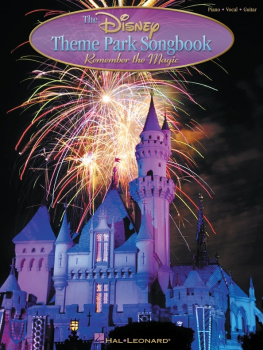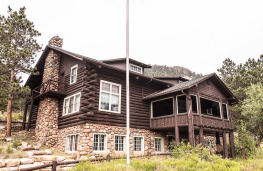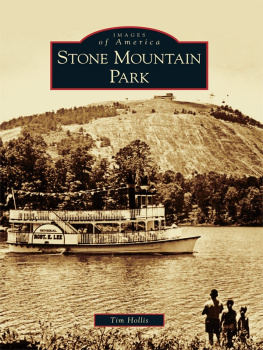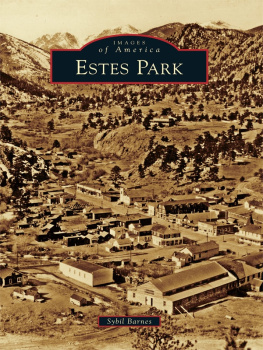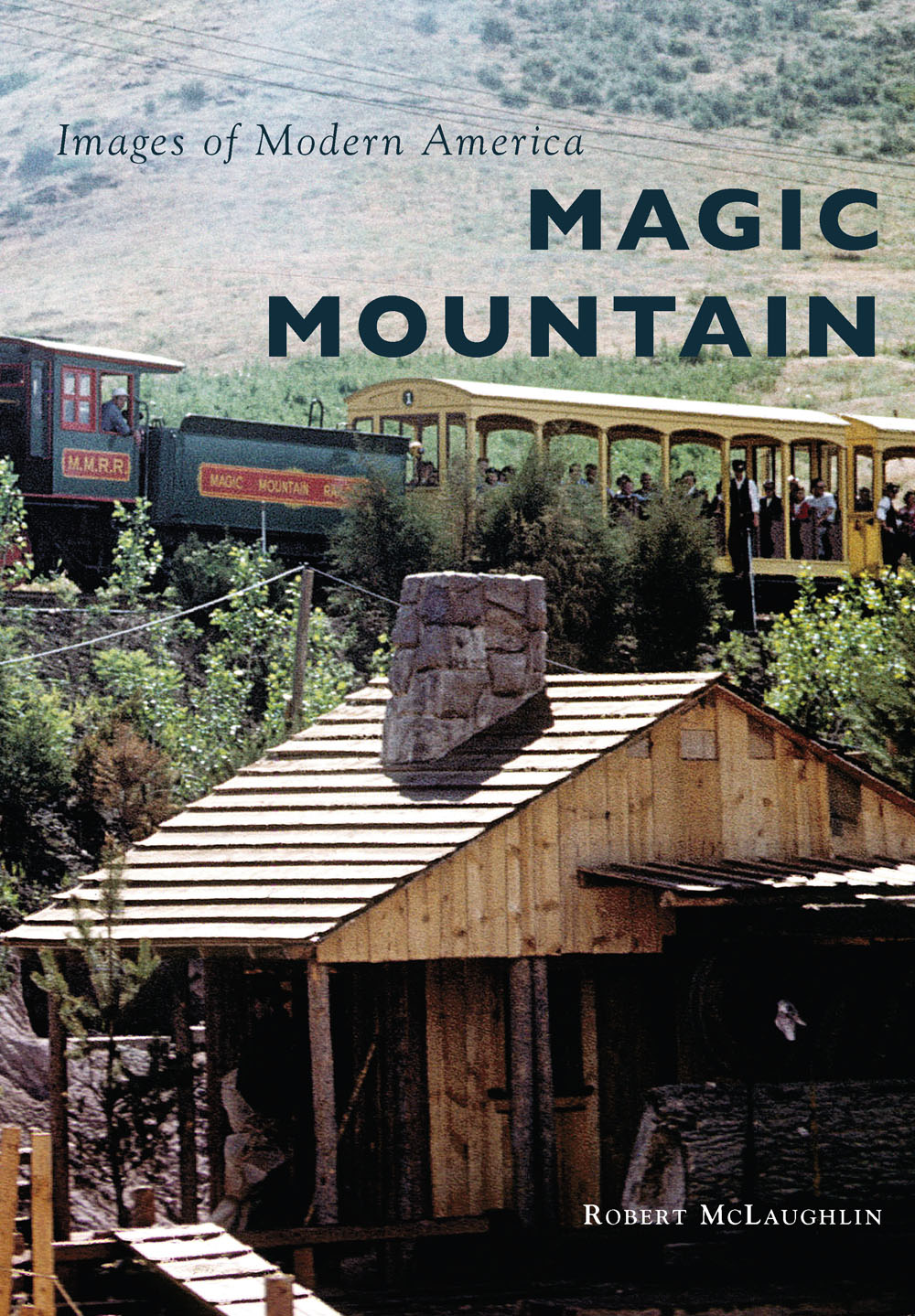
Images of Modern America
MAGIC
MOUNTAIN

Following Disneylands lead, Magic Mountain designers drew this birds-eye concept plan to reflect the story line for the desired themes within the park. (Courtesy of Rick Gardner.)
FRONT COVER: Magic Mountain Railroad (Courtesy of Ron and Stephen Peck; see )
UPPER BACK COVER: Park entrance (Courtesy of Ron and Stephen Peck; see )
LOWER BACK COVER (from left to right): Administration Building (Courtesy of Ron and Stephen Peck; see )
Images of Modern America
MAGIC
MOUNTAIN
ROBERT MCLAUGHLIN

Copyright 2016 by Robert McLaughlin
ISBN 978-1-4671-3475-0
Ebook ISBN 9781439655948
Published by Arcadia Publishing
Charleston, South Carolina
Library of Congress Control Number: 2015953869
For all general information, please contact Arcadia Publishing:
Telephone 843-853-2070
Fax 843-853-0044
E-mail
For customer service and orders:
Toll-Free 1-888-313-2665
Visit us on the Internet at www.arcadiapublishing.com

Magic Mountain is dedicated to its founder, Walter F. Cobb (right); his assistant Monty Pike; and Deputy Marshal Leroy Allen. Shown with Cobb is Lt .Gov. Frank Hays (left) at ground-breaking ceremonies held September 3, 1957. (Courtesy of the Denver Public Library, Western History Collection, Call No. 2129.)
CONTENTS
ACKNOWLEDGMENTS
After five books, it is amazing my wife, Terry, can still stand correcting this dyslexics attempt at spelling, and my daughter Jamie typed my completely hand-printed manuscript, so I thank both of you. Tim McSherry scanned the primary images from the Allen-Pike collection, and Kris Thomas Pickett scanned the final images selected for this book, which included digital editing. Great job, Tim and Kris. A thank-you goes to the entire Arcadia team, including Stacia Bannerman, Chrissy Smith, Ryan Easterling, and director of imprints Katie Kellett. My friend and railroad historian Bill Robie gets the unsung hero award; I thank you for all your help. It was great to interview Leroy Allen and Monty Pike; we all thank you for sharing your first-hand knowledge of Magic Mountain. That also goes for their wives, Beverly and Grace. Special thanks go to Rick Gardner and Ricks aunt Sharon Gardner for access to the Cobb family collection. Ricks overall knowledge of Goldens history was a terrific source to rely on. Stephen Pike also gets a special thanks for sharing his dad, Rons, excellent photograph collection. Thank you, Donna and Mark, for letting me use your expansive open space at your summer home to organize the image story line for all my books. Mike and Russ McGoodwins dad, Jim, was a general manager at the park. It was fun to interview Russ who was just 17 years old when he worked as a laborer during the week and an actor on weekends. Thanks to his brother Mike for sharing a photograph of their dad. Amy Woodward gets my reporter of the year award for her February 26, 2015, story on Heritage Square for Colorado Community Media. This story attracted several new leads, including Norma Stevens, who, with her dad, worked at Magic Mountain and shared her familys photographs. Jerry Kannapinn and John Fisher also contributed to the story line because of Amys story, thank you. Colorado Aerial Photo Service owner John Young supplied the beautiful aerial photographs of Magic Mountain. You and your manager Doug are great. I would like to recognize and thank the following people for their help: Coi E. Drummond-Gehrig from the Denver Public Library, Wendy Hall from the Boulder Carnegie Branch Library for local history, and Roy Johnson and Matt Isaacks from the Colorado Railroad Museum Library. Also contributing to this project are Dennis Walla, Mike Diener, Jeff Bradley, Rick Purcell, Yvonne Lashmett, Chung Park, Denver radio station KELWs Rick Crandall, Rod Pilcher, John Coker, LMG VIDS, attorney Tom Mullen, Darren Leafblad, Linda Detroy Alexander, Chip Parfet, and former Heritage Square manager Terry Raney and current manager Pete Bovis. As for our four adult children Kerry, Jamie, Tracy, and Micah, if you do not read my new book, I am changing the locks on our house.
Unless otherwise noted, all images appear courtesy of the authors collection.
INTRODUCTION
Welcome to Magic Mountain. There is going to be a historical timeline running through the next five chapters. The authors timeline started on March 24, 2000, when he purchased nine Pleasure Island postcards at a church antique show in his adopted hometown of Wakefield, Massachusetts. After having a friend enlarge the postcards, they were posted on the local town information stations along a walking path around Lake Quannapowitt. This chance encounter with nine postcards was the unofficial start of the Friends of Pleasure Island, which became a 501-C in April 2001, with a goal to document Pleasure Islands history to share with current and future generations.
During my very early research on Pleasure Island, three parks appeared besides it on our local librarys microfilm machines screen; they were Disneyland, Magic Mountain, and Freedomland. From several years of research, interviews, and site visits, Pleasure Island and Freedomland were released for the 50th anniversaries, with Pleasure Island in 2009 and Freedomland in 2010. Arcadia Publishing rolled out a new series called Images of Modern America, featuring color photographs, in January 2014. Pleasure Island 19591969, released on June 30, 2014, was the first book in this series to be released in New England. On March 2, 2015, Freedomland 19601964 was released. It is my pleasure to introduce this authors third book in this exciting new seriesMagic Mountain.
As discussed in my previous books, amusement parks have been part of Americas culture for a very long time. Around the turn of the 19th century, parks with the title trolley parks started to appear across the American landscape. Because trolley companies paid for electricity seven days a week, they lost money on weekends when the working population was not utilizing its services. To remedy lost income, trolley companies built amusement parks so patrons would access these venues on the underserved trolley lines.
These parks offered a variety of amusements such as carousels, boat rides and boat rentals, picnic groves, band concerts, dance halls, an assortment of dining choices, and, in some of these parks, much more. One of these trolley parks was located in Kansas City, Missouri. Its name was Electric Park, and one of its guests in the 1910s was a young boy by the name of Walt Disney. Reportedly, Disney would include aspects of his early memories of Electric Park in his vision for Disneyland. Many of these trolley parks evolved into traditional amusement parks that currently operate throughout this country.
With the Great Depression and World War II in the rearview mirror, America was on a roll. Massive upgrades to this countrys road infrastructure connected us from the smallest villages to the largest cities. With a bumper crop of baby boomers and measurable disposable income, the 1950s were the ideal time for a new type of family entertainment. This is where Magic Mountains history merges with Disneylands beginnings.
Next page

